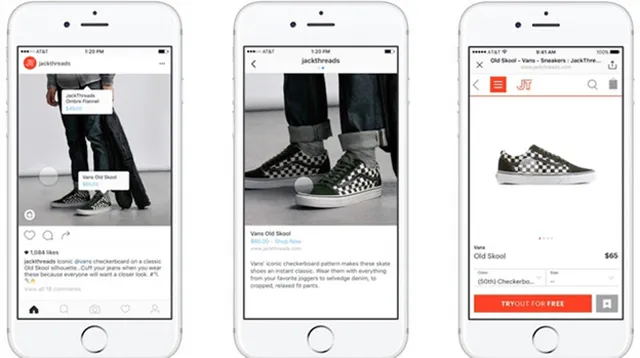E-Commerce Trends in 2025 to Sell More
Table of contents
- What You Need to Know About E-Commerce Trends in 2025 to Sell More
- Artificial Intelligence: How Can We Use It for E-Commerce?
- Smart Search
- Chatbots
- Advanced personalization
- Third-Party Cookies Discontinuation in Chrome
- How to prepare?
- The Growing Mobile E-Commerce Market
- What should you take into account?
- Checking the mobile-friendliness of your E-commerce website
- Social Marketing Tools: How to Use Them Right?
- Expiring social content
- Live videos
- Product tagging
- The Bottom Line
What You Need to Know About E-Commerce Trends in 2025 to Sell More
If we look back, we’ll see how dramatically the E-commerce landscape has recently changed. The proliferation of AI technology, chatbots, Google's mobile-first ranking algorithm, and social marketing tools has significantly aided online merchants in selling more.
Considering that nearly in every online niche, the competition is ramping up faster than the growth of demand, you simply can’t ignore these trends. If you do, you run the risk of being overtaken by your competitors.
In this article, we’ll show you how you can align your business strategies with relevant E-commerce technologies in order to tap into new growth opportunities.
Let’s roll.
Artificial Intelligence: How Can We Use It for E-Commerce?
Look around — AI is everywhere. In department stores, at self-checkout cash registers, airport security checkouts, and in our smartphones, laptops, and tablets. It is predicted that by the year 2050, most of our daily operations will be managed by artificial intelligence.
E-commerce has begun incorporating AI elements as well.
More and more online merchants are adopting AI tools (or even develop their own AI apps) to improve customers’ shopping experience, analyze shopping behavior, segment databases, and even find new leads.
Below are some examples of using AI in E-commerce.
Smart Search
I bet you have abandoned tons of websites because they failed to deliver relevant results for your search queries. That basically happens because the onsite search is getting more complicated — more and more people tend to rely on longer queries to find what they’re looking for.
Yes, some smart engines like Sphinx, Solr, and ElasticSearch can significantly improve your internal site search. However, none of them guarantees 100% relevant results.
AI can put an end to this issue once and for all. Now, there are AI and machine learning tools capable of learning from your customers and adjusting search results to their behavior and personal needs.
Clarifai is a great example of incorporating AI into onsite search. This service enables developers to tag metadata to photos, thus creating an algorithm for recognizing objects in images. That can be a whole new level of visual search on E-commerce websites.
On the downside, at the moment, these services are pretty costly and are beyond the budgets of most small and mid-size businesses.
Chatbots
Chatbots are already widely used by big brands. For instance, Domino's (Dom), H&M (Kik), and Uber (own chatbot) created their own solutions for optimizing different aspects of their online businesses.
Basically, chatbots are communication programs designed for a variety of purposes. Bots can interact with customers 24/7, help in configuring products and orders, handle sales, take payments, and a lot more.
Most E-commerce chatbots are custom-built. You can create a chatbot exclusively for your business needs. Nowadays, there are a lot of chatbot companies that specialize in this field. The good thing is that it won’t cost you much. Additionally, you can get a ready-to-use E-commerce chatbot.
Advanced personalization
You probably know that a smart personalization approach improves user experience and builds long-term brand loyalty. Now, you can optimize this aspect with the help of machine-learning technologies and artificial intelligence. Here’s an example to inspire you:
Proper Cloth
The manufacturer of bespoke men’s shirts introduced a new way of product personalization.

Using a set of questions and a machine-learning mechanism, they collect maximum information about your preferences, individual body characteristics, and even shirt special features, such as a watch allowance on one side. Next, they create a product that is fully customized according to your requirements.
The manufacturer’s website retains all customers’ preferences as well as their measurements. So whenever you visit this store, you won’t have to enter all the required details again.
You can also add multiple sets of measurements and styles and switch between them if needed.
Houzz
If you’ve ventured for changing something in your house, this website is a real godsend.

Houzz.com was established to help house owners with repairing, remodeling, and redecorating their living places. All you need to do is specify a room or house type, interior or exterior styles, your favorite colors, and this website will curate hundreds of images that fit your preferences.
But that’s not all this service can do. The most interesting feature is that once you find a project you like most, Houzz will automatically display a list of items to buy for it or show you similar pieces. It can also connect you with the local decorators, designers, repairing and redecorating services who can bring this idea to life. Thus, you can create a highly individualized project and quickly find the services that will implement it for you.
Summing up, whether you have just launched an online business or are an experienced online retailer, you can’t ignore the AI trend in the industry.
Third-Party Cookies Discontinuation in Chrome
The discontinuation of third-party cookies, scheduled for 2024, represents a significant trend in the digital landscape. As more users are accessing the web from their mobile devices, major browsers like Chrome are taking steps to enhance privacy and reduce cross-site tracking. Google's plan to disable third-party cookies in a phased approach, starting with 1% of users in Q1 2024 and eventually ramping up to 100% in Q3 2024, is a response to these changing user behaviors and privacy concerns.
The move toward deprecating third-party cookies is part of a broader initiative known as the Privacy Sandbox. This initiative is aimed to achieve a balance between user privacy and the functionality required to keep online content and services accessible to all. While third-party cookies are crucial for various functions such as sign-in, fraud protection, and advertising, they are also a primary enabler of cross-site tracking, which raises privacy issues.
How to prepare?
To prepare for this change, website owners and developers need to take several key steps, including auditing their use of third-party cookies, testing for any potential issues, and considering alternatives such as partitioned cookies (CHIPS) or related website sets (RWS). Additionally, migrating to privacy-focused web APIs is essential for use cases that rely on third-party cookies.
The Growing Mobile E-Commerce Market
Google is working hard to keep its algorithms in line with users’ needs.
Given that mobile E-commerce sales are projected to account for 62% of the market, with a total value of 3,436 trillion U.S. dollars in 2027, and considering various other metrics that show a continuously growing number of users accessing the web from their mobile devices, it's only natural that search engines are increasingly prioritizing mobile optimization.
At the beginning of 2017, there was alarming news about the search engine rolling out a “mobile-first” version of its index, which stirred a lot of questions and debates among E-commerce store owners. On May 22, 2023, John Mueller from Google confirmed that the last batch of websites has transitioned from desktop-first to mobile-first indexing. As a result, having a mobile-friendly site is now the only way to achieve a favorable position in organic search results.
What should you take into account?
First, if you have a mobile version of your website, you should make it as similar to your desktop version as possible. This is about preserving the same or similar amount of content, saving important links, page and site navigation elements, etc.
An ideal approach is to create a carefully considered and planned responsive version of your desktop pages. In this way, most of your content will remain the same, without being reduced for mobile. The same thing is true for most of your site navigation elements and important internal links.
As for canonical links, you don’t need to change anything. Google will persist in using these links as guides to provide the right results to users who search on both desktop and mobile platforms.
Checking the mobile-friendliness of your E-commerce website
The most popular tool to check your mobile site view is the Fetch and Render tool in the Google Search Console. You just need to specify the mobile smartphone user-agent and then look at your site preview. This is basically the same mobile version of your website that Google sees. If you notice that some content or links are missing, you should fix that and then run the tool again.
Social Marketing Tools: How to Use Them Right?
The most fascinating thing about the world of social media is that it keeps evolving. Cool features appear almost every month, giving E-commerce merchants new opportunities to promote their brands and sell a larger amount of products. The only thing one needs to do is to take advantage of the social features and use them the right way.
Expiring social content
Snapchat was a pioneer in this field. Later on, Instagram, Facebook, VK, Telegram, and other social networks also adopted this technology and started deleting content after a certain period of time.

Such content can be successfully used by E-commerce vendors for a number of reasons.
- First and foremost, it creates a sense of urgency. Prospective customers know that this video is going to be deleted, so they don’t postpone watching it.
- Secondly, this content exists only while it is relevant. Your customers won’t be shown a promo image of a sale that ended a couple of days ago.
- Last but not least, expiring content gives merchants the possibility to cut through the informational noise and reach potential buyers in the places they spend most of their time.
Live videos
Live streaming video is a great way to interact with your audience. With the help of this tool you can do a number of important things:
Educate your customers by organizing webinars, showcasing products, telling your customers how to get the most out of a certain product, etc.
- Answer frequently asked questions or provide feedback for complaints and new product requests, etc.
- Give an inside look at your business by showing your customers "behind the scenes" of your online store, telling them about the way it works, about your team members, or about yourself.
- Promote an upcoming event (sale, trade show, conference) or tease a product that will be on sale in your online store soon.
Product tagging
Another useful marketing tool — Instagram's shoppable tags that let merchants tag products right in their photos (in the same way users can tag their friends). That significantly improves customers’ shopping experience and lets them purchase a product in a couple of clicks.

Facebook lets you do something similar when you create an ad, offering to add a "Buy Now" button with a link to your product right under your Facebook post. Moreover, Facebook allows you to create dynamic ads with links to several products. So, in case you would like to show your products to people who've already expressed interest while browsing your website, you can create an ad of such type.
The Bottom Line
The reality is that we live in a fast-changing world. It means that the practices and tactics that used to work well may no longer be effective today. So, to stay afloat, you need to keep educating yourself and master new things in your niche.
Put these strategies into action to boost your sales and outpace your competition. And stay tuned for more valuable insights.
Updated on Feb 28, 2025





